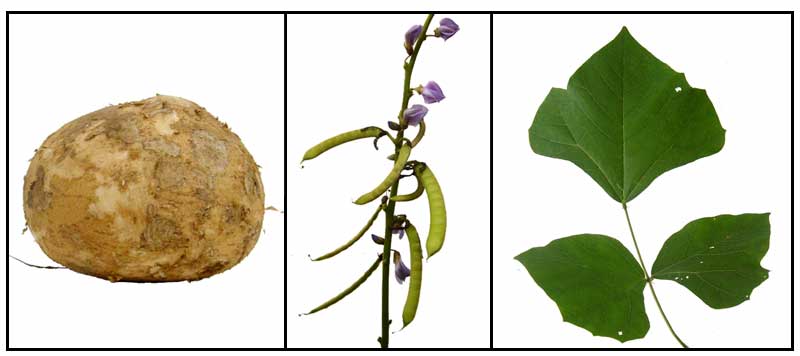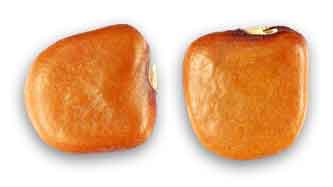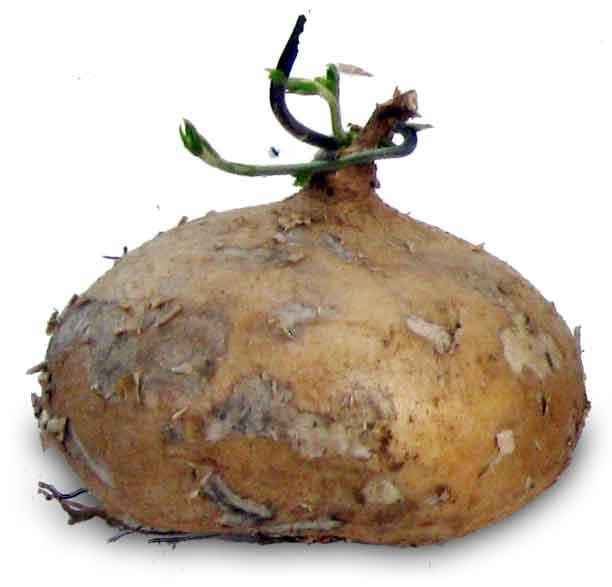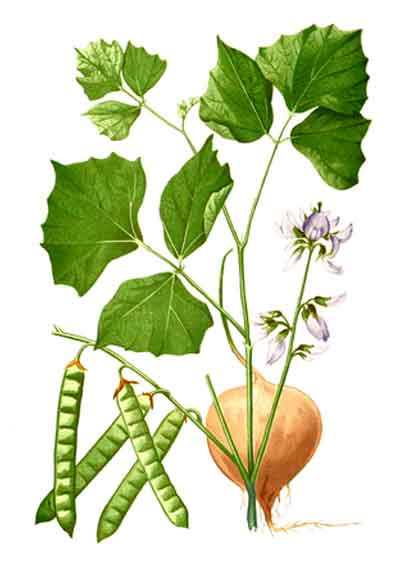|  Gen
info Gen
info
Pachyrhizus is derived
from the Greek word meaning "thick root."
 Botany Botany
Sinkamas is a coarse, climbing,
herbaceous vine growing from large, edible, turnip-shaped, fleshy roots.
Leaflets, at least the terminal ones, are broader than long, up to 15 centimeters long and 20 centimeters wide, with
a deltoid base, shallowly lobed upper half, and the lateral leaves inequilateral. Racemes are up to 45 centimeters
in length, while the lower nodes produce short branches and the other nodes several flowers each. Flowers are pale blue or blue and white, 2 to 2.5 centimeters long,
about 1.5 centimeters wide. Pods are about 10 centimeters long, 10-12 millimeters wide, flat and
hairy, containing 8 to 10 seeds.
Distribution
- In settled
areas, in thickets and hedges throughout the Philippines, at
low and medium altitudes.
- A native of tropical America.
- Now pantropic.

Constituents
• Roots are high in carbohydrates; good source of calcium and
iron.
• Young pods are also good sources of calcium and iron.
• Seeds yield a colorless and limpid oil, 38.4%
• Seeds also yield a poisonous substance, pachyrrhizid, a glucoside;
toxic to fish if pounded and dropped in water.
• The seeds also contain a toxic resin.
• Nutrient analysis of tubers showed a high level of moisture, appreciable carbohydrates, crude fiber and protein, with negligible lipid, with a caloric value of 39 kcal per 100 g. Micro- and macro-nutrient analysis showed a potential source of potassium, sodium, phosphorus, calcium and magnesium. Tuber also yielded significant ascorbic acid and detected thiamine, riboflavin, pyridoxine, niacin and folic acid. (6)
• Study of 10 accessions of detoxified yam bean seeds (two from P. erosus) yielded 29.2-32.1 g/100 g protein, 31.3-33.0 g/100 g carbohydrates, 24.1-25.6 g/100 g total fat, 7.5-8.1 g/100g crude fiber, and 3.4-4.1 g/100 g ash. Defatted P. erosus seed flour yielded 45.6-48.8 g/100g protein, 32.6-46.5 g/100 g total carbohydrate, 6.7-7.1 g/100 g crude fiber, 6.0-6.4 g/100 g ash, and 5.2/100 g crude fat. (see study below) (24)
• Nutrient analysis of fresh, raw, 100 g of Jicama yielded: (Principle): enery 38 kcal, carbohydrate 8.82 g, protein 0.72 g, total fat 0.19 g, cholesterol 0 mg, dietary fiber 4.9 g; (Vitamins) folates 12 mg, niacin 0.2 mg, pantothenic acid 0.135 mg, pyridoxine 0.042 mg, thiamin 0.020 mg. vitamin A 21 IU, vitamin C 20.2 mg, vitamin E 0.46 mg; (Electrolytes) sodium 4 mg, potassium 150 mg; (Minerals) calcium 12 mg. copper 0.048 mg, iron 0.60 mg, magnesium 12 mg, manganese 0.60 mg, zinc 0.16 mg; (Phytonutrients) carotene 13 ug.
Properties
• Pounded seeds are toxic to fish; powdered seeds are reportedly fatal to dogs.
• Seeds considered acaridal and insecticidal.
• Studies have suggested antiviral, anti-osteoporosis, antifungal, antioxidant, immunomodulatory, insecticidal, and skin whitening properties.
Parts used
Roots, seeds, and stems.
Uses
Edibility / Nutritional
- Roots are eaten raw
or prepared.
- Young
pods sometimes used as vegetable.
- Roots are high in carbohydrates; good source of calcium and
iron.
Folkloric
- Decoction of the roots
used as a diuretic.
- Warmed poultice of the stem pulp applied to painful areas in the leg.
- Seeds are laxative; and the oil of seeds is purgative in doses of 40
gms.
- Tincture from seeds used for treatment of herpes.
- In Taiwan, roots used for fever and hemorrhages.
Others
- Plant can be used as green manure. (25)
- Root extract used as ingredient in commercial cosmetic preparations. (25)
Studies
•
CNS Depressant Activity: PE seed is known to contain
rotinoids, flavonoids, phenylfuranocoumarins with antifungal, antisecretory,
antibacterial and spasmolytic activities. Study showed CNS depressant
effect with decreased locomotor activity, muscle relaxation, antianxiety
and antiaggressive activity. (1)
 •
Anti Herpes Simplex Virus (HSV): Studies on seeds of
PE isolated 9 known components – 5 rotenoids, two isoflavonoids,
one phenylfuranocoumarin and a monosaccharide. Moderate anti-herpes
simplex virus activity was observed. (2) •
Anti Herpes Simplex Virus (HSV): Studies on seeds of
PE isolated 9 known components – 5 rotenoids, two isoflavonoids,
one phenylfuranocoumarin and a monosaccharide. Moderate anti-herpes
simplex virus activity was observed. (2)
• Yam bean seed poisoning: Five patients presented with signs and symptoms mimicking acute cyanide intoxication with perioral numbness, nausea and vomiting after ingesting soup made from yam bean seeds. One patient progressed to severe metabolic acidosis and coma, requiring aggressive therapy. (3)
• Anti-Osteoporosis / Root: Study of the effects of EA extract of root of P. erosus on bone loss in ovariectomized rat model showed significant prevention of bone loss in OVX rats. Significant prevention of uterine atrophy and increased body weight gain were observed. Results suggest a phytoestrogen compound that could be of benefit in postmenopausal women. (4)
• Antifungal / Phytochemicals: A dichlormethane extract yielded rotenone, erosone, paquirrizone, dolineone and paquirrizine. The acetone extract yielded dehydroneotenone. The secondary metabolites significantly inhibited post-harvest fungi. (5)
• Nutrient Analysis / Phytochemicals: Tuber showed a high level of moisture, appreciable carbohydrates, crude fiber and protein, with negligible lipid, with a caloric value of 39 kcal per 100 g. Micro- and macro-nutrient analysis showed a potential source of potassium, sodium, phosphorus, calcium and magnesium. Tuber also yielded significant ascorbic acid and detected thiamine, riboflavin, pyridoxine, niacin and folic acid. (6)
• Antioxidant: Study showed highest Total Antioxidant Status (TAS) for raw jam bean with 50% methanol extract, and lowest with water extraction. (7)
• Immunomodulatory: Study evaluated the immunomodulatory effect of bengkoang fiber extract in vitro and in vivo. BFE facilitated IgM production by human hybridoma cell line HB4C5 cells. Also, BFE dose-dependently facilitated production of IgM, IgG, and IgA by mouse primary splenocytes. Results suggest BFE has positive in vitro and in vivo effects on the immune system. (10)
• Insecticidal: Study evaluated the insecticidal efficacy of mintweed, yam bean and celery seed extracts on Aedes aegypti L. Yam bean (Pachyrhizus erosus) was most toxic to Ae. aegypti 2nd instar larvae and adults. YSE in combinations produced strong synergistic effects to the other extracts. (11)
• Yam Starch as Sunscreen: Yam starch (Pachyrhizus erosus (L.) Urb.) was evaluated in Swiss Webster female mice strains for sunscreen properties. Results showed sunscreen activity in vivo in mice. Increase in concentration showed an increase in viscosity, while color, odor, and homogeneity of the formulation did not change during storage. (12)
• Hypoglycemic Effect: Study evaluated the inhibitory effect of jicama extract on α-glucosidase, α-amylase, and postprandial hyperglycemic in STZ-induced diabetic mice. Results showed decrease in postprandial blood glucose level with high inhibitory activity against α-glucosidase and α-amylase activities. (14)
• Functional Properties of Yam Bean Starch: Study on the functional properties of starch extracted from yam bean showed the starch paste to have a high viscosity profile, high retrogradation tendency and low stability on cooking. Similar to those of cassava starch, yam bean is a potential new source of starch. (15)
• Antioxidant / Skin Whitening / Anti-Tyrosinase Inhibiting Property: In Indonesia, roots have been used as excipient for sun screening and skin whitening paste. Study for active compounds yielded three isoflavonoids: daidzein, daidzein-7-O-ß-glucopyranose, and 5-hydroxy-daidzein-7-O-ß-glucopyranose, and a new pterocarpan (8,9-furanyl-pterocarpan-3-ol, which showed antioxidant activities (SC50 values of 2.11, 11.86, 0.69, and 7.86 respectively, with tyrosinase inhibiting activities with IC50 of 5.35, 22.20, 4.38, and 7.49 mM, respectively. (16)
• Oviposition Deterrent Activity: Study showed the potential of crude extract of yam bean in preventing diamondback moth, Plutella xylostella, from ovipositing on its plant host. (17)
• Rotenone Deterrent Activity: Study evaluated the cytotoxicity of rotenone isolated from P. erosus seeds on K562 human leukemia cells. Rotenone exhibited significant cytotoxic activity (IC50=13.05 µM) by MTT assay. Rotenone induced cell death and caspase-3 activation. (18)
• Diuretic / Hypotensive Effect: Study of methanolic extract of tubers of Pachyrhizus erosus in male Sprague-Dawley rats showed potential blood pressure lowering activity at dose of 200 mg/kg. A diuretic effect was evident only at 50 mg/kg dose. (19)
•
No Effect in Hampering Blood Glucose: Study of bengkoang juice showed no effect in hampering blood glucose increase in 40 alloxan-induced diabetic Wistar rats. (20)
• Platelet Inhibitory Effects / Cardiovascular Benefits / Root: Study evaluated the cardiovascular benefits of juices from two commonly consumed fruits in Thailand--Pachyrhizs erosus (yam bean) and Psidium guajava (guava)--in healthy volunteers. Results showed acute inhibitory effects of yam bean root juice and guava fruit juice on ex vivo collagen-induced platelet aggregation in healthy subjects. Following yam bean root juice ingestion, systemic nitrate converts to nitrite and into NO which may attenuate platelet responses to collagen stimulation. (21)
• Biodiesel
/ Seed Oil Methyl Esters: Study evaluated seed oil methyl esters for fuel properties according to biodiesel standards. The seed oil generally met fuel property specifications with its elevated content of saturated fatty acid methyl esters, high cloud point, and a high cetane number. (22)
• Phytoestrogenic Potential: Study evaluated the phytoestrogenic potential of yam bean on ovarian and uterine tissue structure of premenopausal mice. Results showed both secondary and tertiary follicle proliferation while the endometrial tissue of the uterus showed uterine glandular proliferation. Study showed yam bean to be a natural estrogen source. (23)
• Composition and Functional Properties / Yam Bean Seeds: Although seeds are rich in protein, they are not used due to the high content of toxic rotenone. In the study, yam bean seeds from ten accessions (two from P. erosus) were detoxiri3e and nutritional qualities were determined. Study suggests yam bean seed has potential for use in both food and non-food applications. (see constituents above) (24)
• Daidzein / Potential Effect on Myometrium / Tuber: Study evaluated daidzein compounds yam tuber extract for effects on myometrium rat model. Results showed the level of daidzein in blood and urine of rats administered yam tuber juice is lower than pure daidzein treatment. Results of administration of yam tuber juice showed significant myometrium proliferation in rats. Results suggest the phytoestrogen compounds from P. erosus has potential as natural estrogenic in women. (26)
• Lessening Intestinal Coliforms / Probiotic Potential: Study evaluated the effect of P. erosus in lessening intestinal coliforms compared to prebiotic (positive control) and water (negative control). Stools were evaluated for color, consistency, and growth of colonies. Results showed P. erosus is not only a vegetable, but also a good substitute for probiotic drinks. (27)
• Immunomodulatory / Stimulation of Phagocytic Activity: Study evaluated the effects of bengkoang fiber extract (BFE) on macrophages in vitro and in vivo. The BFE stimulated phagocytic activity of J773.1 cells, and significantly facilitated production of TNF-a and interleukin (IL)-6 and mouse peritoneal macrophages. BFE facilitated gene expression of nitric oxide synthase and cyclooxygenase-2 and stimulated the innate immune response as well as acquired immune responses. (29)
• Prevention of Excessive Blood Glucose and Body Weight: Jicama has been shown to exert immunomodulatory effect both in vitro and in vivo. Study evaluated the tuberous part of Jicama to see if the fiber could prevent the development of diabetes and obesity caused by a high sugar diet. Results showed jicama fiber could effectively sustain blood glucose homeostasis and improved body weight and WAT mass profile against the development of diabetes and obesity cause by high sugar diet. (30)
• Effect on Skin Improvement / Mask Pack Containing Yam Bean: Studies have previously shown anti-oxidant and anti-melanogenic effects. Study evaluated the skin improvement effects resulting from use of a mask pack containing yam bean extracts. Results showed increase in moisture and oil content of facial skin, with improvement in dryness and skin tone. Results suggest potential for use in functional cosmetics. (31)
• Melanin Inhibitory Effect / Antioxidant: Study evaluated the anti-oxidant activity and anti-melanogenic effect of yam bean extract and fractions. The ethanol extract scavenged DPH and ABTS effectively compared to the water extract. The ethyl acetate fraction effectively suppressed melanin accumulation in a dose-dependent manner. Results suggest potential as a cosmetic material with antioxidant and antimelanogenic activities. (32)
Availability
Widely cultivated
for its edible roots.
|


 Gen
info
Gen
info  Botany
Botany
 •
Anti Herpes Simplex Virus (HSV): Studies on seeds of
PE isolated 9 known components – 5 rotenoids, two isoflavonoids,
one phenylfuranocoumarin and a monosaccharide. Moderate anti-herpes
simplex virus activity was observed. (
•
Anti Herpes Simplex Virus (HSV): Studies on seeds of
PE isolated 9 known components – 5 rotenoids, two isoflavonoids,
one phenylfuranocoumarin and a monosaccharide. Moderate anti-herpes
simplex virus activity was observed. (

